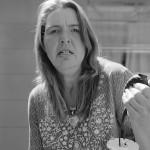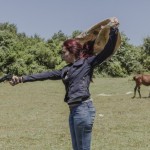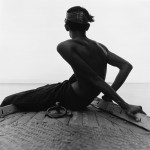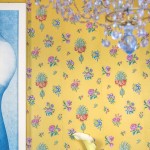Klompching Gallery in Brooklyn (DUMBO), NY is celebrating it’s annual summer show, FRESH 2013. Each summer, the gallery seeks to showcase fresh voices in contemporary photography. Curated by collector/curator W.M. Hunt and Klompching Gallery owner Darren Ching, FRESH 2013 features five fresh photographers, each with a unique and personal vision : Priya Kambli, Manuel Cosentino, Maxine Helfman, Chang Kyun Kim, and Peter Croteau. In addition, ten photographers are showcased the
on-line showcase: Julie Brook Alexander, Mary Ellen Bartley, Zhenjie Dong, Camilo Echavarria, Kenneth Golden, Bill Jackson, Clay Lipsky, Robert Moran, J. Scriba, and Ilona Szwarc. The exhibition opens on July 18th (6-8pm opening) and runs through August 10th.
Priya Kambli
One of my most startling early childhood memories is of seeing one of my father’s painstakingly composed family photographs pierced by my mother. She cut holes in them so as to completely obliterate her own face while not harming the image of my sister and myself beside her. Even as a child I was aware that this act was quite significant – but what it signified was beyond my ability to decipher. As an adult I continue to be disturbed by these artifacts. Even though her incisions have a violent quality to them, as an image-maker I am aesthetically drawn by the physical mark, its presence and its careful placement. These marred artifacts form a reference point and inspiration for my body of work, Kitchen Gods. Like my mother, I alter these photographs to modify the stories they tell.
Pigment Prints, 8″ x 5″ image on 17″ x 22″ sheet
Edition of 5, from $1,600 ($1,250 unframed)
Aaji, 2012-2013 from the Kitchen Gods series © Priya Kambli
Baba, 2012-2013 from the Kitchen Gods series © Priya Kambli
Dada Aajooba and Mama, 2012-2013 from the Kitchen Gods series
© Priya Kambli
Dada Aajooba and Dadi Aaji, 2012-2013 from the Kitchen Gods series © Priya Kambli
Mama and Dada Aajooba, 2012-2013 from the Kitchen Gods series
Meena Atya and Me, 2012-2013 from the Kitchen Gods series
© Priya Kambli
Manuel Cosentino
I am interested in exploring alternative ways to present, interact with, and consume photography as a way to activate and facilitate the dialogue between the artwork and the viewer. “Behind a Little House” is an intimate participatory art project which can only be accessed through the pages of an artist book and chooses to sacrifice dissemination (large-scale web2.0 approach) to reclaim a physical connection with the audience. I wanted the viewer to start as an outside observer, a spectator, and then suddenly realize that they can participate – the wall mounted photographs lead up to the artist book where everyone is invited to contribute by drawing on the last photograph sheared on each page, giving impromptu co-authors the freedom to shape the direction and the content of the artwork. The project intends to start a conversation with the public;its nature is purposefully left mutable, open to chance and to change.
images: Pigment Print, 14″ x 21″ image on 18.5″ x 25.5″ sheet
Edition of 15 + 2 APs, from $1,350 ($1,100 unframed)
Behind a Little House (A), 2008 from Behind a Little House series
© Manuel Cosentino
Behind a Little House (B), 2009 from Behind a Little House series
© Manuel Cosentino
Behind a Little House (C), 2009 from Behind a Little House series
© Manuel Cosentino
Behind a Little House (D), 2009 from Behind a Little House series
© Manuel Cosentino
Behind a Little House (E), 2008 from Behind a Little House series © Manuel Cosentino
Behind a Little House (F), 2009 from Behind a Little House series
© Manuel Cosentino
Behind a Little House (G), 2008 from Behind a Little House series
© Manuel Cosentino
Behind a Little House (H), 2009 from Behind a Little House series
© Manuel Cosentino
Maxine Helfman
Some words have a double meaning such as the word fabrication. It can be a myth or misrepresentation, or the materials something is constructed with. It challenges the double standard created with a simple piece of clothing….a dress. The simplicity of the photos is a strong contrast to the complexity of the issues it raises.
Pigment Print, 17″ x 25″ image on 24″ x 36″ sheet
Edition of 12, from $2,400 ($1,800 unframed)
White Satin Bow, 2012 from the Fabrication series ©Maxine Helfman
Blue Organza, 2012 from the Fabrication series ©Maxine Helfman
Size 7 Floral, 2012 from the Fabrication series ©Maxine Helfman
Pink Irridescent, 2012 from the Fabrication series ©Maxine Helfman
Peter Croteau
Spaces of dross are the in-between waste spaces in the landscape. Left as a result of sprawl, these spaces are in a constant state of flux between use and disuse. I explore these mundane spaces using the camera as an apparatus that can reframe and order the world. Through my use of the large format camera I create images of dross that also function as markers of the sublime. In focusing on spaces of dross, but using my camera more like a canvas, I set up a dualistic relationship between earth and sky in order reference painterly representations of the sublime. This relationship speaks to a high/low binary that exists in the American landscape between spaces of preservation and spaces of waste, humans’ free will to shape land and its use, as well as the ideologies that define the way we understand natural forms.
Pigment Print, 46″ x 36″ image on 50″ x 40″ sheet
Edition of 5, from $4,850 ($4,000 unframed)

Mountain I, 2012 from the Mountain series © Peter Croteau
Mountain IV, 2012 from the Mountain series © Peter Croteau
Mountain VII, 2012 from the Mountain series © Peter Croteau
Chang Kyun Kim
We see and perceive. Our mind processes what we see into a certain impression, and eventually into a memory. What interests me is what kind of particles and remnants we have in our mind before they become a memory or after the memory is forgotten. Since we are provided with so many images everyday in this image-flooded generation, I believe we are very likely to have similar or identical memories that have been created by ‘given’ images. Based on this thought, I wanted to visualize the subconscious state of certain collective memories – that are chaotically diverse and complex, but similarly patterned after all – by deconstructing and randomly reordering the images to imply that the extreme diversity eventually becomes one simple pattern.
Pigment Prints adhered to canvas, 40″ x 30″
Edition: Unique, $1,400
Six Thousand Impressions of Times Square, 2013 from the Before or After The Memory series © Chang Kyun Kim
Two Thousand Impressions of Las Vegas, 2013 from the Before or After The Memory series © Chang Kyun Kim
Three Thousand Impressions of U.S. Senators, 2013 from the Before or After The Memory series © Chang Kyun Kim










































































